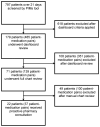Electronic surveillance and pharmacist intervention for vulnerable older inpatients on high-risk medication regimens
- PMID: 25366414
- PMCID: PMC4337022
- DOI: 10.1111/jgs.13057
Electronic surveillance and pharmacist intervention for vulnerable older inpatients on high-risk medication regimens
Abstract
Objectives: To develop and evaluate an electronic tool to assist clinical pharmacists with reviewing potentially inappropriate medications (PIMs) in hospitalized elderly adults.
Design: Pilot intervention.
Setting: Academic tertiary care hospital.
Participants: Hospitalized adults aged 65 and older admitted to the general medicine, orthopedics, and urology services during a 3-week period in 2011 who were administered at least one medication from a list of 240 PIMs.
Intervention: A computerized PIMS dashboard flagged individuals with at least one administered PIM or a high calculated anticholinergic score. The dashboard also displayed 48-hour cumulative narcotic and benzodiazepine administration. Participants were ranked to reflect the estimated risk of an adverse event using logical combinations of data (e.g., use of multiple sedatives in a nonmonitored location). In a pilot implementation, a clinical pharmacist reviewed the flagged records and delivered an immediate point-of-care intervention for the treating physician.
Measurements: Clinician response to pharmacist intervention.
Results: The PIMS dashboard flagged 179 of 797 individuals (22%) admitted over a 3-week period and 485 participant-medication pairs for review by the clinical pharmacist. Seventy-one participant records with 139 participant-medication pairs required additional manual review of the electronic medical record. Twenty-two participants receiving 40 inappropriate medication orders were judged to warrant an intervention, which was delivered by personal communication over the telephone or text message. Clinicians enacted 31 of 40 (78%) pharmacist recommendations.
Conclusion: An electronic PIM dashboard provided an efficient mechanism for clinical pharmacists to rapidly screen the medication regimens of hospitalized elderly adults and deliver a timely point-of-care intervention when indicated.
Keywords: acute care; clinical informatics; geriatrics; medication safety; pharmacy intervention; vulnerable elderly.
© 2014, Copyright the Authors Journal compilation © 2014, The American Geriatrics Society.
Conflict of interest statement
Figures


References
-
- Gallagher PF, Barry PJ, Ryan C, et al. Inappropriate prescribing in an acutely ill population of elderly patients as determined by Beers' Criteria. Age Ageing. 2008;37:96–101. - PubMed
-
- Peterson JF, Kuperman GJ, Shek C, et al. Guided prescription of psychotropic medications for geriatric inpatients. Arch Intern Med. 2005;165:802–807. - PubMed
-
- Chew ML, Mulsant BH, Pollock BG, et al. Anticholinergic activity of 107 medications commonly used by older adults. J Am Geriatr Soc. 2008;56:1333–1341. - PubMed
-
- Rothberg MB, Pekow PS, Liu F, et al. Potentially inappropriate medication use in hospitalized elders. J Hospl Med. 2008;3:91–102. - PubMed
Publication types
MeSH terms
Grants and funding
LinkOut - more resources
Full Text Sources
Other Literature Sources

